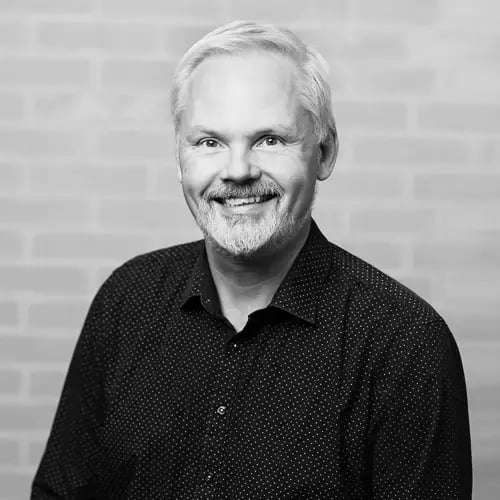Schou
Builds Large New Logistics Centre in Kolding
January 2007
Between 1999 and 2004, Bent Brandt repeatedly outgrew the physical boundaries of the company through organic growth. The company expanded and rented additional space to the extent that it was financially feasible and then consolidated operations on a newly developed site with entirely new facilities. Langebæk has acted as an advisor throughout the entire process.

‘The results have not been long in coming. Our service level is higher than ever, and the number of error-prone customer orders is at its lowest in many years,’ says Morten Højholt, Logistics and Purchasing Director at Bent Brandt.
It is rarely possible to design a company’s physical facilities based purely on functional requirements for warehouse and logistics capacity. The shape of the facilities is often predetermined – due to factors such as the size of the plot, existing buildings, planning regulations, and similar considerations – and the logistics concept must take this into account. However, it was precisely the opportunity to start an optimal design process that Bent Brandt had when the company moved to Lisbjerg, just outside Aarhus, in 2004. After years of growth, Bent Brandt’s level of activity had become larger than the existing facilities could handle.
‘In 1999, we already asked Langebæk to map out the entire operation, so we could get an overview of the business, particularly the volume, and find out whether we could continue with "business as usual" in line with the expected growth. We couldn’t, due to the logistics structure,’ explains Morten Højholt, Logistics and Purchasing Director.
Bent Brandt has three business areas: Retail sales of household goods and machinery, design of professional kitchens, and technical services. The three areas complement each other and are all essential for profitability, but retail sales account for 90% of the warehouse and logistics capacity. With 9,000 product lines, the range is extensive, and there are large differences between the products, which include everything from teaspoons and champagne glasses to automatic potato peelers and industrial dishwashers. There are also variations in the required stock levels for each individual item.
In addition, customers have specific requirements. Among these, product availability, and thus the company’s ability to deliver, is the most important.
‘Our range is constantly expanding with new products and segments, but rarely replaces the continuity of already registered products, which is why we naturally end up with quite a broad warehouse stock,’ says Morten Højholt.
‘This helps explain why, between 1999 and 2004, we had to operate from up to six different locations: Growth simply put increasing demands on warehouse and logistics capacity.’
It was primarily the internal logistics that caused difficulties. A typical customer order consists of many different items and quantities that must be processed for delivery to the customer in a single package. Since many of the items are fragile, it is crucial that the order is packed in the most secure way.
‘Picking and packing across many different locations increases the risk of mistakes, particularly when most of the workflows are manual,’ emphasises Morten Højholt.
‘Until 2004, we did all picking and packing manually. In the worst case, we had to collect items from all six locations, which were then transported to the packing area. And all items on an order had to be picked before packing could begin. Picking and packing were two separate processes.’
Back in 1999, Langebæk presented four logistics concepts, three of which were based on the existing premises, and the fourth was a Greenfield solution. Langebæk concluded that the existing facilities would be insufficient within approximately five years, but that it would be worthwhile to expand them in the short term to allow time to find a suitable plot and design the Greenfield solution. This would involve integrating picking and packing into a paperless workflow.
The challenge in this regard is that the shipping packaging is the first item to be picked. This requires that the total volume of an order be calculated very precisely. As part of the overall solution, Langebæk therefore recommended that Bent Brandt invested in a warehouse and logistics system that, based on master data about the items and predefined packing criteria, calculates the optimal sequence for picking and packing. After a tender process, Apport Systems was selected as the WMS supplier.
‘It is not possible to optimise logistics as a whole based on calculations about what works best for an individual order,’ says Morten Højholt. ‘The composition of all the orders for the day is simply not standardised enough. The new solution has given us greater flexibility and efficiency because it makes it possible to pick and pack in the optimal sequence, considering the day’s total orders, item types, quantities, and the items' locations in the warehouse.’
‘We have been in close dialogue with – and followed Langebæk’s advice all the way,’ says Morten Højholt. ‘We expanded and rented space as long as we could, and when it was time to move, we had found the site here in Lisbjerg and could ask Langebæk to design the final warehouse and logistics solution. It was then incorporated into the proposal for the architect and contractor, who were responsible for the actual construction. It was the ideal design process from a business perspective.’
